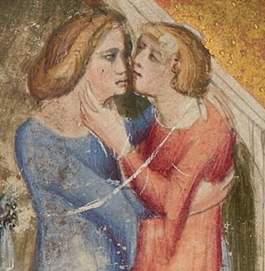Marozia: A Medieval Lesbian Ghost

Look what happens when you don't confess to "wanton lust"!
The stories are there, but you sometimes need to seek them out.
Marozia is less than a mere footnote in history, but at least she is noted. She lived and she had a story, and thanks to the correspondence of St. Pier Damiani (1007-1072), she comes to us through ten centuries.
Before we tell Marozia’s story, let’s take a quick look at Pier Damiani (Peter Damian in English). Pier was a monk who became a Cardinal under Pope Leo IX. Highly regarded through the centuries, Dante placed Pier in one of the highest levels of Paradise in the Divine Comedy.
According to various histories and hagiographies, Pier had a rough start to life. Born in Ravenna in 1007, he was the youngest child of a noble but impoverished family. At some point after his parents died, his older brother adopted him. That didn’t work out well for Pier. The brother starved him and put him to work watching pigs. Another brother, Damianus, an arch-priest in Ravenna, pitied the situation of young Pier. Damianus took him away to be educated, and Pier then — presumably in gratitude — added the brother’s name to his own, becoming Pier Damiani.
At first Pier studied at Ravenna, then at Faenza, and ultimately found himself at the University of Parma, where at age 25 he was so well regarded that he became a teacher there. At this point, Pier’s life was distinctly secular in nature.
Around 1035, Pier decided to leave secular life and became a monk. Rising through the hierarchy of the monastery, not only did he eschew luxuries; he set out to impose severe disciplines upon himself and his fellow monks. Included in his reform was the practice of flagellation.
On the other hand, presumably recognizing that the arduous lifestyle imposed upon his fellows was, to the least, rather draining, he also established a daily siesta.
Over his life, Pier was an orphan, a laborer, a student, a monk, a hermit, a priest, a theologian, a teacher, a writer, a poet, an ascetic, a penitent, a prior, a reformer, a bishop, and a cardinal. Then, after he died, was canonized as a saint.
And one thing Pier did throughout his life was write. He wrote a lot. And among his writings is a tale of a woman named Marozia.
The story of Marozia is an odd one coming from Pier. Written at a time when he was very strong on the notion that monks should pray to the saints for divine intercession (intended to save the souls of the dead from being tormented in the afterlife for their sins), this tale of Marozia contains no element of monkish influence.
In fact, not only were the monks not required as mediators for the damned, it was the damned themselves who prayed for salvation and attained it through the mercy of the Virgin Mary. So many of these tortured souls were saved that a group "exceeding the entire population of the City of Rome" were on a ghostly pilgrimage to render their thanks.
No monks required.
Here is a retelling of what he wrote[1]:
"A priest named John told me of an event that happened in Rome on the Feast of the Blessed Assumption of Mary (August 15). Many people came out during the night carrying lanterns to visit various churches and at the Basilica on Capitoline Hill a women glimpsed her godmother who had died in the previous year. The Basilica was crowded and the woman couldn’t reach her godmother, so she decided to go out of the church to a quiet narrow lane to await her exit.
Sure enough, the godmother reached the spot where the woman was waiting. The woman quickly asked "are you not Marozia, my godmother, who recently died?". Marozia acknowledged that she was indeed the same, and then the woman asked her how she was doing. She replied:
"Until today a heavy punishment oppressed me because I had disgraced myself in my youth by succumbing to the enticement of wanton lust with girls my own age. And I am sad to say that for some reason I forgot about this and even though I went to the priest for confession, I did not receive his judgment on this sin. But today the queen of the world (the Virgin Mary) answered our prayers and freed me with many others from those places of punishment, and such a great multitude of souls has on this day been rescued from torment by her intervention that their number exceeds the entire population of the city of Rome. For this reason, we are visiting the holy places dedicated to our glorious lady all over the city to show our thanks most joyfully for the great benefits of her mercy."
Marozia saw the skepticism in the woman’s face, and went on to say:
"So that you believe without a doubt that my story is true, know that a year from today, on this very same feast day, you will most certainly die. But if you live any longer, which is not possible, you will prove that I was clearly a liar."
From this point on, the woman lived a more modest life and began to wear only sackcloth. Then, one year later, on the next Feast of the Assumption, she sickened and died.
And that is all.
We know nothing of the woman who saw the ghost and died as predicted. We know nothing more of Marozia. But, at least, we can remember her name.
[1] Epistola 168, ed. Kurt Reindel in Die Briefe des Petrus Damiani , Monumenta Germaniae Historica; Die Briefe der Deutschen Kaiserzeit, 4 vols. (Munich: Monumenta Germaniae Historica, 1983–1993), vol. 4, pp. 242–243
Would you like to read other posts? If so, please click the Home Page link below:

You, Dear Reader, are much needed and appreciated.
Everything written requires a reader to make it whole. The writer begins, then you, dear reader, take in the idea and its image, and so become the continuation of its breath. Please subscribe so that my words can breathe. Consider this my hand, reaching out to yours.
